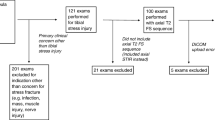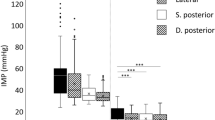Abstract
Objective
To validate the diagnostic performance of an in-scanner exercise-based magnetic resonance imaging (MRI) examination used to screen for chronic exertional compartment syndrome (CECS). Final clinical impression and intracompartmental needle manometry (INM) served as the reference standards.
Materials and methods
Consecutive patients, referred by a sports medicine physician or orthopedic surgeon, underwent the MRI examination for lower extremity pain over the past 4 years and 9 months. Utilizing a diagnostic T2-weighted intensity ratio threshold of 1.54, established by a prior cohort of patients, sensitivity, specificity, predictive value, and diagnostic odds ratio were calculated for the anterior compartments. The means of the T2-weighted intensity ratios were compared using the Wilcoxon rank sum test.
Results
A total of 79 patients were identified, and 76 met the inclusion criteria and were evaluated. Of these, 23 met clinical diagnostic criteria. Sensitivity and specificity were 96% (95% CI: 79–99%) and 87% (95% CI: 75–94%) using the established threshold of 1.54. T2-weighted intensity ratio provided excellent discrimination with a concordance statistic of 0.96 (95% CI: 0.91–1.00). In the subset of 36 patients with INM results, 23 patients met criteria for CECS, although only 19 patients met both INM and clinical criteria. The sensitivity and specificity of the MRI examination relative to INM results were 87% (95%: 70–96%) and 62% (95% CI: 36–82%) respectively.
Conclusion
In-scanner exercise-based MRI demonstrated reliability and reproducibility as a non-invasive screening test for CECS, thus reducing the need for invasive INM.




Similar content being viewed by others
References
Blackman PG. A review of chronic exertional compartment syndrome in the lower leg. Med Sci Sports Exerc. 2000;32(3 Suppl):S4–10.
Schubert AG. Exertional compartment syndrome: review of the literature and proposed rehabilitation guidelines following surgical release. Int J Sports Phys Ther. 2011;6(2):126–41.
Lecocq J, Isner-Horobeti ME, Dupeyron A, Helmlinger JL, Vautravers P. Exertional compartment syndrome. Ann Readapt Med Phys. 2004;47(6):334–45.
Birtles DB, Minden D, Wickes SJ, Puxley MKP, Llewellyn AMG, Casey A. Chronic exertional compartment syndrome: muscle changes with isometric exercise. Med Sci Sports Exerc. 2002;34(12):1900–6.
Shah SN, Miller BS, Kuhn JE. Chronic exertional compartment syndrome. Am J Orthop (Belle Mead NJ). 2004;33(7):335–41.
Hutchinson MR, Ireland ML. Common compartment syndromes in athletes. Treatment and rehabilitation. Sports Med. 1994;17(3):200–8.
Tucker AK. Chronic exertional compartment syndrome of the leg. Curr Rev Musculoskelet Med. 2010;3(1–4):32–7.
Fleckenstein JL, Canby RC, Parkey RW, Peshock RM. Acute effects of exercise on MR imaging of skeletal muscle in normal volunteers. AJR Am J Roentgenol. 1988;151(2):231–7.
Sjogaard G, Saltin B. Extra- and intracellular water spaces in muscles of man at rest and with dynamic exercise. Am J Physiol. 1982;243(3):R271–80.
Adams GR, Duvoisin MR, Dudley GA. Magnetic resonance imaging and electromyography as indexes of muscle function. J Appl Physiol. 1992;73(4):1578–83.
Fisher MJ, Meyer RA, Adams GR, Foley JM, Potchen EJ. Direct relationship between proton T2 and exercise intensity in skeletal muscle MR images. Invest Radiol. 1990;25(5):480–5.
Hazlewood CF, Chang DC, Nichols BL, Woessner DE. Nuclear magnetic resonance transverse relaxation times of water protons in skeletal muscle. Biophys J. 1974;14(8):583–606.
Litwiller DV, Amrami KK, Dahm DL, Smith J, Laskowski ER, Stuart MJ, et al. Chronic exertional compartment syndrome of the lower extremities: improved screening using a novel dual birdcage coil and in-scanner exercised protocol. Skeletal Radiol. 2007;36(11):1067–1075.
Eskelin MK, Lotjonen JM, Mantysaari MJ. Chronic exertional compartment syndrome: MR imaging at 0.1T compared with tissue pressure measurement. Radiology. 1998;206(2):333–7.
Amendola A, Rorabeck CH, Vellett D, Vezina W, Rutt B, Nott L. The use of magnetic resonance imaging in exertional compartment syndromes. Am J Sports Med. 1990;18(1):29–34.
George CA, Hutchinson MR. Chronic exertional compartment syndrome. Clin Sports Med. 2012;31(2):307–19.
Pedowitz RA, Hargens AR, Mubarak SJ, Gershuni DH. Modified criteria for the objective diagnosis of chronic compartment syndrome of the leg. Am J Sports Med. 1990;18(1):35–40.
Blackman PG, Simmons LR, Crossley KM. Treatment of chronic exertional anterior compartment syndrome with massage: a pilot study. Clin J Sport Med. 1998;8(1):14–7.
Verleisdonk EJ, Schmitz RF, van der Werken C. Long-term results of fasciotomy of the anterior compartment in patients with exercise-induced pain in the lower leg. Int J Sports Med. 2004;25(3):224–9.
Diebal AR, Gregory R, Alitz C, Gerber JP. Forefoot running improves pain and disability associated with chronic exertional compartment syndrome. Am J Sports Med. 2012;40(5):1060–7.
Mohler LR, Styf JR, Pedowitz RA, Hargens AR, Gershuni DH. Intramuscular deoxygenation during exercise in patients who have chronic anterior compartment syndrome of the leg. J Bone Joint Surg Am. 1997;79(6):844–9.
Tsintzas D, Ghosh S, Maffulli N, King JB, Padhiar N. The effect of ankle position on intracompartmental pressures of the leg. Acta Orthop Traumatol Turc. 2009;43(1):42–8.
Hislop M, Tierney P. Intracompartmental pressure testing: results of an international survey of current clinical practice, highlighting the need for standardised protocols. Br J Sports Med. 2011;45(12):956–8.
Van den Brand JG, Nelson T, Verleisdonk EJ, van der Werken C. The diagnostic value of intracompartmental pressure measurement, magnetic resonance imaging, and near-infrared spectroscopy in chronic exertional compartment syndrome: a prospective study in 50 patients. Am J Sports Med. 2005;33(5):699–704.
Verleisdonk EJ, van Gils A, van der Werken C. The diagnostic value of MRI scans for the diagnosis of chronic exertional compartment syndrome of the lower leg. Skeletal Radiol. 2001;30(6):321–5.
van den Brand JG, Verleisdonk EJ, van der Werken C. Near infrared spectroscopy in the diagnosis of chronic exertional compartment syndrome. Am J Sports Med. 2004;32(2):452–6.
Owens S, Edwards P, Miles K, Jenner J, Allen M. Chronic compartment syndrome affecting the lower limb: MIBI perfusion imaging as an alternative to pressure monitoring: two case reports. Br J Sports Med. 1999;33(1):49–51.
Edwards PD, Miles KA, Owens SJ, Kemp PM, Jenner JR. A new non-invasive test for the detection of compartment syndromes. Nucl Med Commun. 1999;20(3):215–8.
Takebayashi S, Takazawa H, Sasaki R, Miki H, Soh R, Nishimura J. Chronic exertional compartment syndrome in lower legs: localization and follow-up with thallium-201 SPECT imaging. J Nucl Med. 1997;38(6):972–6.
Oturai PS, Lorenzen T, Norregaard J, Simonsen L. Evaluation of Tc-99 m-tetrofosmin single-photon emission computed tomography for detection of chronic exertional compartment syndrome of the leg. Scand J Med Sci Sports. 2006;16(4):282–6.
Trease L, van Every B, Bennell K, Brukner P, Rynderman J, Baldey A, et al. A prospective blinded evaluation of exercise thallium-201 SPET in patients with suspected chronic exertional compartment syndrome of the leg. Eur J Nucl Med. 2001;28(6):688–95.
Andreisek G, White LM, Sussman MS, Langer DL, Patel C, Su JW, et al. T2*-weighted and arterial spin labeling MRI of calf muscles in healthy volunteers and patients with chronic exertional compartment syndrome: preliminary experience. AJR Am J Roentgenol. 2009;193(4):W327–33.
Balduini FC, Shenton DW, O’Connor KH, Heppenstall RB. Chronic exertional compartment syndrome: correlation of compartment pressure and muscle ischemia utilizing 31P-NMR spectroscopy. Clin Sports Med. 1993;12(1):151–65.
Roberts A, Franklyn-Miller A. The validity of the diagnostic criteria used in chronic exertional compartment syndrome: a systematic review. Scand J Med Sci Sports. 2011; doi:10.1111/j.1600-0838.2011.01386.x.
Slimmon D, Bennell K, Brukner P, Crossley K, Bell SN. Long-term outcome of fasciotomy with partial fasciectomy for chronic exertional compartment syndrome of the lower leg. Am J Sports Med. 2002;30(4):581–8.
Howard JL, Mohtadi NG, Wiley JP. Evaluation of outcomes in patients following surgical treatment of chronic exertional compartment syndrome in the leg. Clin J Sport Med. 2000;10(3):176–84.
Acknowledgements
This study received funds from a research grant by the Mayo Clinic Department of Radiology.
Conflict of Interest
The authors declare that they have no conflict of interest.
Author information
Authors and Affiliations
Corresponding author
Rights and permissions
About this article
Cite this article
Ringler, M.D., Litwiller, D.V., Felmlee, J.P. et al. MRI accurately detects chronic exertional compartment syndrome: a validation study. Skeletal Radiol 42, 385–392 (2013). https://doi.org/10.1007/s00256-012-1487-1
Received:
Revised:
Accepted:
Published:
Issue Date:
DOI: https://doi.org/10.1007/s00256-012-1487-1




